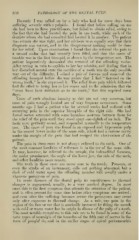Page 826 - My FlipBook
P. 826
836 PATHOLOGY OF THE DENTAL PULP. ;
Recently I was called on by a lady "svho had for some days been
suffering severely with a pulpitis. I found that before calling on me
she had been to three practitioners, but failed to obtain relief, oM'ing to
the fact that she had located the pain in one tooth, while each of the
dentists whom she had consulted had located it in another. The patient
was certain she was right, and her advisers were equally sure that their
diagnosis was correct, and in the disagreement nothing could be done
for her relief. Upon examination I found that she referred the pain to
a second molar that had recently been filled, and that the cause of
trouble was in the first liicuspid, as shown by the temperature test. The
patient imperatively demanded the removal of the offending molar.
After trying in vain to explain to her her mistake, and finding that in
her disturbed mental state the sacrifice of a tooth was the only possible
way out of the difficulty, I seized a pair of forceps and removed the
offending bieuspid before she was aware that I had "fastened on the
wrong tooth," as she expressed it. The relief from pain which followed
had the effect to bring her to her senses and to the admission that she
" must have been mistaken as to the tooth ;" but this required some
days.
Cases of such absolute insanity as this are not very common, but
cases of pain wrongly located are of very frequent occurrence. Some
months ago I had a patient who for several Meeks had suffered with
recurring pain in the superior bicuspids of the right side. She had
forced cotton saturated with some harmless nostrum between them for
the relief of the pain until they stood apart one-eighth of an inch. The
teeth were perfectly sound, and responded normally to the temperature
test. The cause of pain was found in an exposed and hypersemic pulp
in the second lower molar of the same side, A\hich had a carious cavity
under the margin of the gum that had escajied the observation of the
patient.
The pain in these cases is not always referred to the teeth. One of
the most constant localities of reference is in the ear of the same side.
It may, however, be referred to the temple, the infraorbital foramen,
the malar prominence, the angle of the lower jaw, the side of the neck,
and other localities more remote.
The teeth in these cases are never sore to the touch. Pressure, or
even the stroke of an instrument, calls out nothing abnormal, but a
dash of cold water upon the offending member will usually excite a
vigorous paroxysm of pain.
In acute diseases of the dental pulp its sensitiveness to thermal
changes is augmented,- usually, to a very marked degree. In most
cases this is the first symptom that attracts the attention of the patient,
and is oflen present for some time before other symptoms are noticed
and even after the suffering becomes severe the paroxysms may occur
only after exposure to thermal change. As a rule, any pain in the
region of the face or ear that is markedlv increased bv filling the mouth
with cold or warm water has its origin in disease of the pulp of a tooth.
The most notable exceptions to this rule are to be found in some of the
rarer types of neuralgia of the branches of the fifth pair of nerves in the
form of painful tic, and in the earlier stages of apical pericementitis


